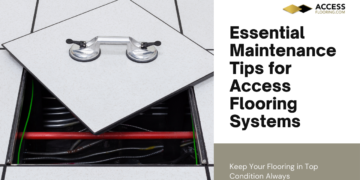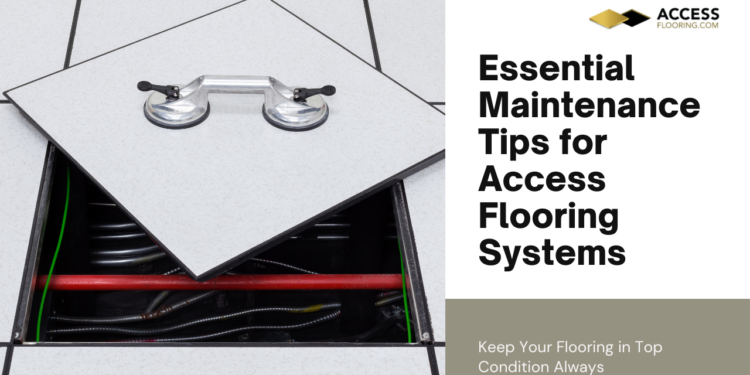Raised access flooring systems are integral to the functionality of modern buildings, particularly in environments like data centres, offices, and server rooms. They provide a versatile platform for managing electrical wiring, ventilation, and communication networks, all while maintaining a sleek, clean aesthetic. However, like any infrastructure, raised access flooring requires regular maintenance and care to ensure optimal performance and longevity. Proper upkeep can prevent costly repairs, maintain safety standards, and extend the lifespan of your flooring system. This guide offers a comprehensive approach to maintaining and caring for your raised access floor.
1. Regular Inspections
One of the most critical aspects of maintaining raised access flooring is conducting regular inspections. These checks ensure that any issues are identified early before they become significant problems.
Key areas to inspect:
- Panels and Tiles: Check for signs of wear, damage, or misalignment. If panels become loose or damaged, they should be replaced immediately to prevent safety hazards.
- Underfloor Space: Ensure that the underfloor area remains clear of dust, debris, and obstructions. Accumulation of dirt can interfere with air circulation, leading to overheating in critical spaces like server rooms.
- Supports and Pedestals: Inspect the structural supports and pedestals to ensure they are firmly in place. Any wobbling or loose pedestals can compromise the floor’s stability and should be addressed promptly.
A routine inspection schedule—typically once every six months—can help you stay on top of potential problems and keep your raised flooring system in peak condition.
2. Cleaning the Surface and Underfloor Area
Cleaning your raised access flooring system goes beyond just keeping the surface free of dirt. Regular cleaning of both the surface and the underfloor space is essential for maintaining air quality and ensuring that cables and systems remain in good condition.
- Surface Cleaning: Use a gentle cleaning solution suitable for the material of your floor panels, whether it’s laminate, vinyl, or carpet. Avoid using harsh chemicals that can degrade the panel surface over time. Ensure that liquids do not seep between the tiles, as this can damage the underfloor components.
- Underfloor Cleaning: The underfloor cavity is prone to accumulating dust, dirt, and debris. Periodic vacuuming using equipment designed for raised flooring spaces is recommended. Special care should be taken not to disturb any cables or ventilation systems. The underfloor area should also be free of moisture, as damp conditions can lead to mould or corrosion of critical infrastructure.
Establish a regular cleaning schedule based on the specific use of the space. Data centres, for example, may require more frequent cleaning due to the sensitivity of the equipment housed within them.
3. Addressing Load and Weight Capacity
Raised access floors are designed to support specific load capacities. Overloading the flooring system can lead to panel or pedestal failure, causing significant damage and safety risks. Ensure that you are aware of the load-bearing limits of your raised floor system and that no heavy equipment exceeds these thresholds.
- Even Distribution of Weight: Ensure that heavy equipment, such as servers or office machinery, is distributed evenly across the floor to avoid placing excessive strain on specific areas. If you need to house particularly heavy equipment, consider reinforcing certain sections with extra supports or heavier-duty panels.
- Reinforced Panels: In some cases, reinforced panels may be necessary for specific areas where load-bearing capacity is a concern. Be sure to consult with your access flooring provider if you anticipate needing additional support.
By adhering to the floor’s load capacity, you can prevent structural damage and ensure that your flooring system remains stable and safe.
4. Panel and Tile Replacement
Over time, individual panels or tiles may show signs of wear and tear, such as scratches, cracks, or stains. In some cases, these panels may need to be replaced to maintain the appearance and functionality of the floor.
- Replacing Damaged Panels: Damaged panels should be replaced as soon as possible. Not only can a damaged panel become a tripping hazard, but it may also reduce the structural integrity of the flooring system. Replacement panels should match the original materials and specifications to ensure a seamless fit.
- Ensuring Proper Fit: When replacing panels, it’s essential to ensure that they fit properly and align correctly with the surrounding floor. Misaligned or poorly fitted panels can create an uneven surface, posing a safety risk and reducing the aesthetic quality of the floor.
Keep spare panels on hand to replace damaged ones as needed, ensuring minimal downtime and a consistent look.
5. Maintaining Cable and Equipment Organisation
One of the primary functions of raised access flooring is to house and organise electrical cables, data networks, and HVAC systems. Proper cable management not only keeps the underfloor space tidy but also helps prevent damage to sensitive equipment.
- Cable Trays and Management Systems: Ensure that all cables are properly routed through cable trays or management systems designed for raised floors. This prevents cables from becoming tangled or damaged, which could lead to system malfunctions or fire risks.
- Preventing Cable Overcrowding: Avoid overcrowding the underfloor space with too many cables. Overcrowding can restrict airflow, leading to overheating. It can also make maintenance tasks more difficult and increase the risk of damage to equipment.
By keeping cables neatly organised and ensuring they are easily accessible, you can reduce the risk of equipment failure and make future maintenance tasks more efficient.
6. Temperature and Humidity Control
In environments like data centres or server rooms, maintaining optimal temperature and humidity levels is crucial for both the equipment and the raised floor system. Excessive heat or moisture can degrade flooring materials and compromise the underfloor components.
- Monitoring Systems: Install temperature and humidity monitoring systems to keep track of environmental conditions. Ensure that HVAC systems are functioning properly to maintain a stable environment.
- Preventing Moisture Build-Up: Moisture can damage both the flooring panels and the underfloor infrastructure. If moisture is detected, address the source immediately and ensure that the area is dried thoroughly.
Consistent climate control helps prevent issues like condensation, mould growth, and material degradation, preserving the longevity of both your flooring system and the equipment housed within.
7. Professional Maintenance and Servicing
While regular in-house inspections and cleaning are essential, professional servicing should also be part of your maintenance routine. Access flooring specialists can conduct more detailed inspections, identify potential problems, and offer solutions that might not be immediately visible during routine checks.
- Scheduled Professional Inspections: Depending on the environment, scheduling a professional inspection once a year or more frequently may be necessary. Professionals can provide detailed reports on the condition of your floor, identify wear patterns, and suggest preventative measures to avoid future issues.
- Specialist Cleaning and Repairs: Some raised flooring systems require specialist cleaning techniques or repairs that in-house teams may not be equipped to handle. Flooring professionals have the expertise and tools to ensure that the system remains in excellent condition.
Investing in professional maintenance can save time and money in the long run, helping you avoid costly repairs or replacements.
Conclusion
A raised access flooring system is a valuable asset in many commercial and industrial spaces, providing flexibility, organisation, and improved functionality. However, like any infrastructure, it requires regular maintenance and care to ensure its optimal performance. By adhering to a routine of inspections, cleaning, and professional servicing, you can prolong the lifespan of your raised floor and ensure it continues to serve your space effectively for years to come. Proper attention to load management, temperature control, and cable organisation will also prevent wear and tear, making your investment in raised access flooring a worthwhile one.








































